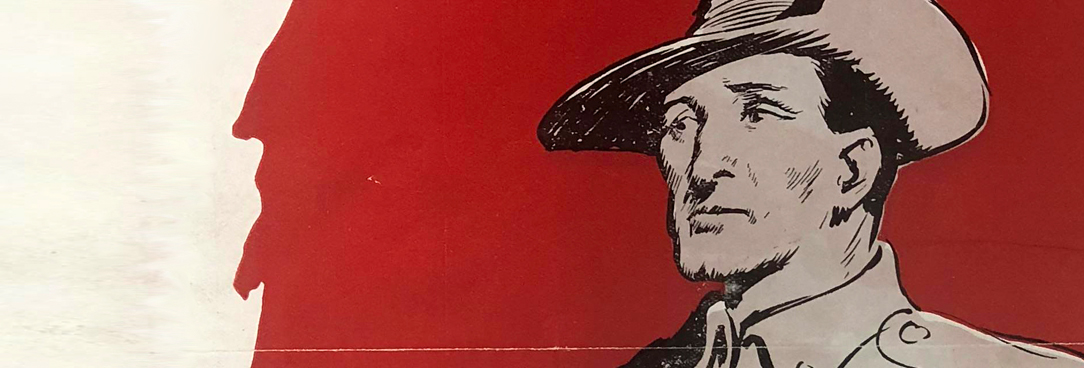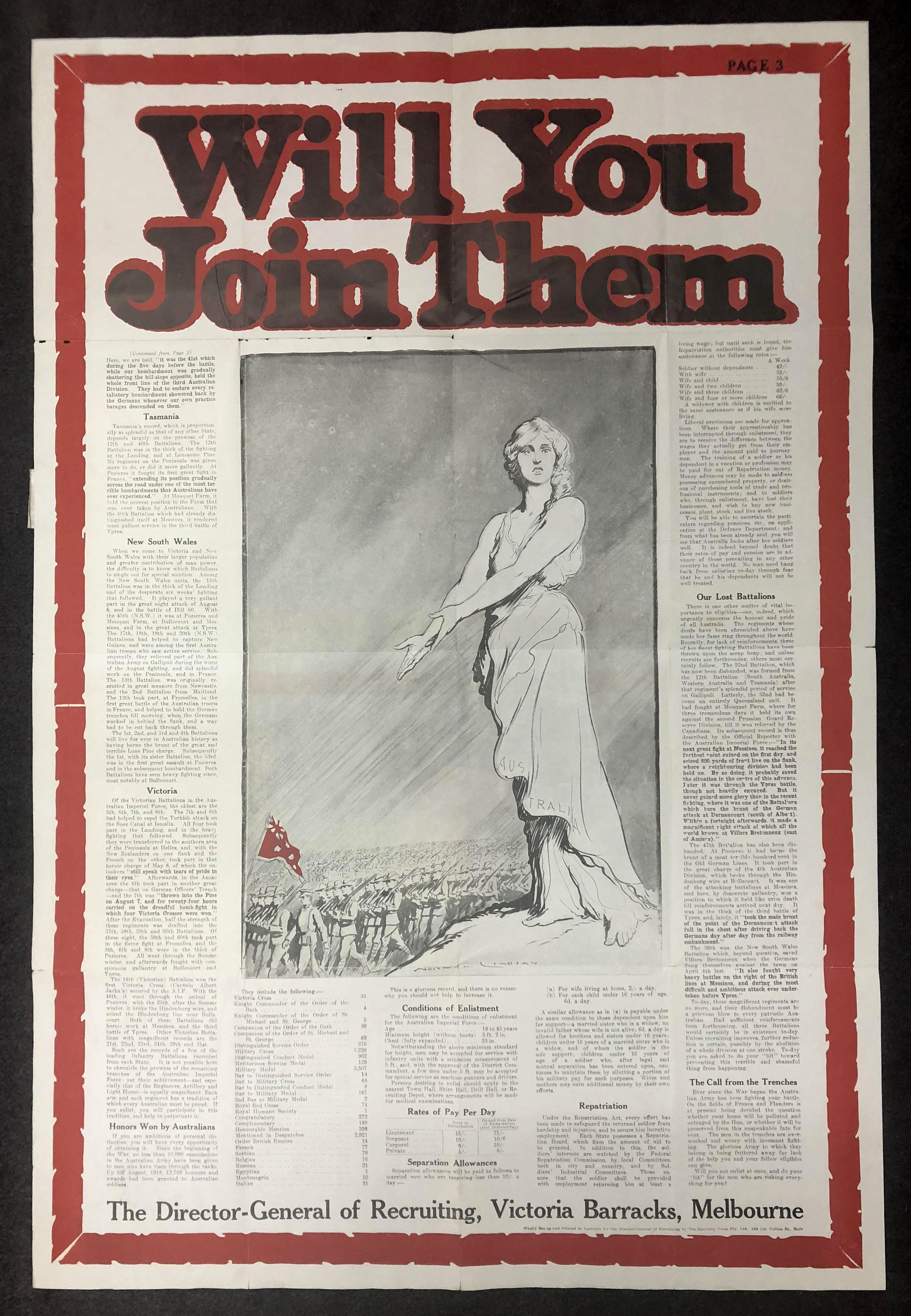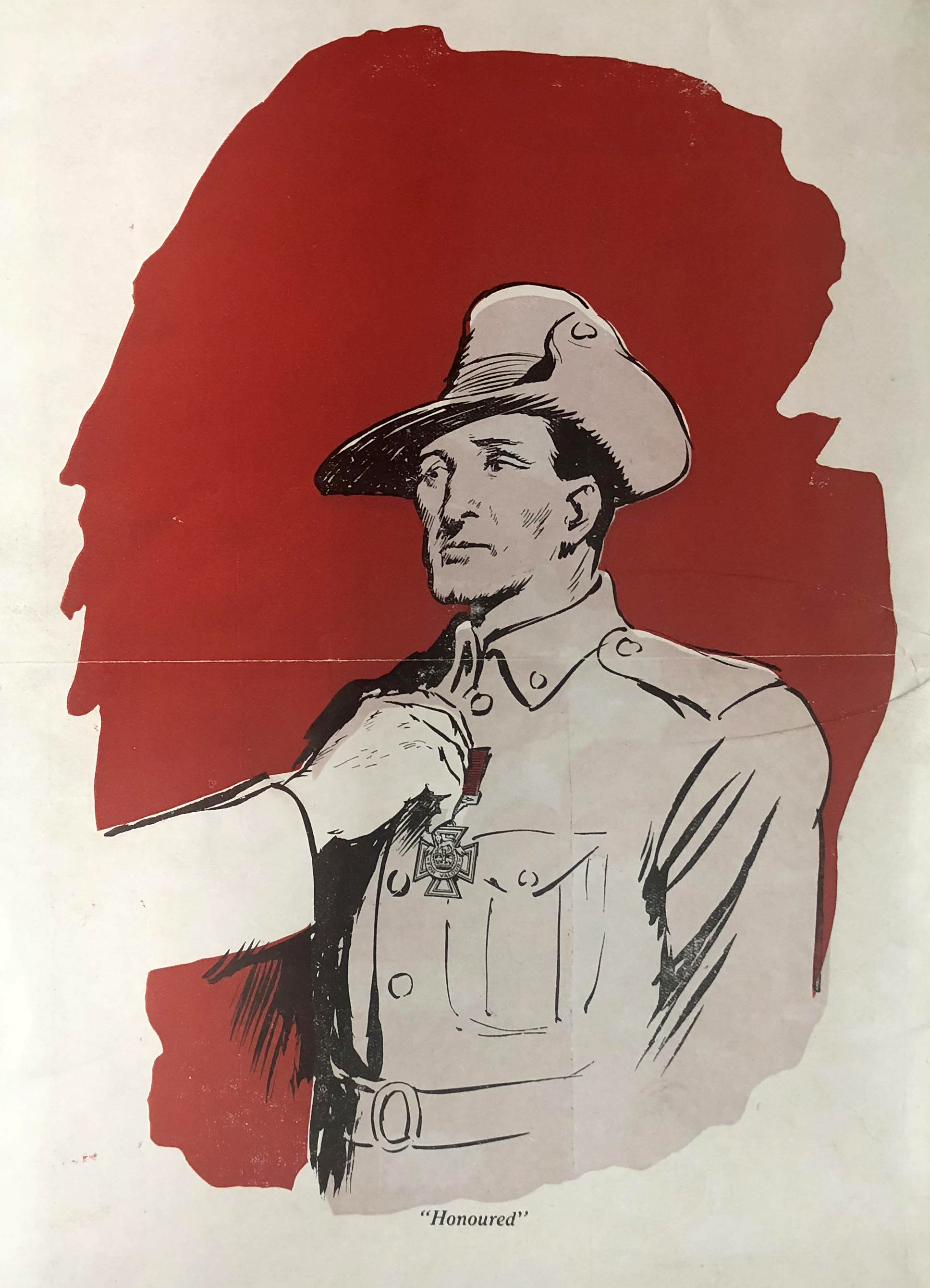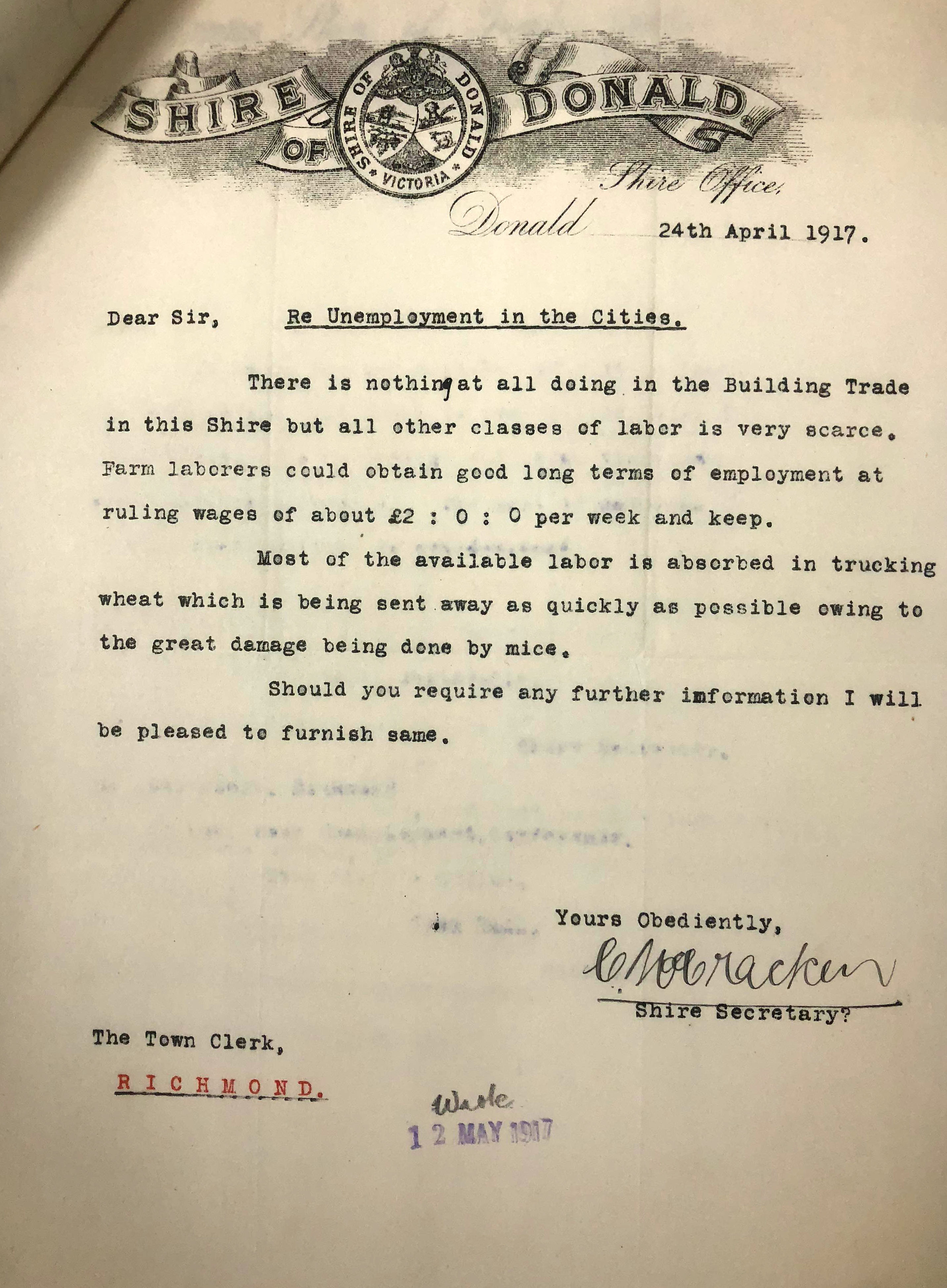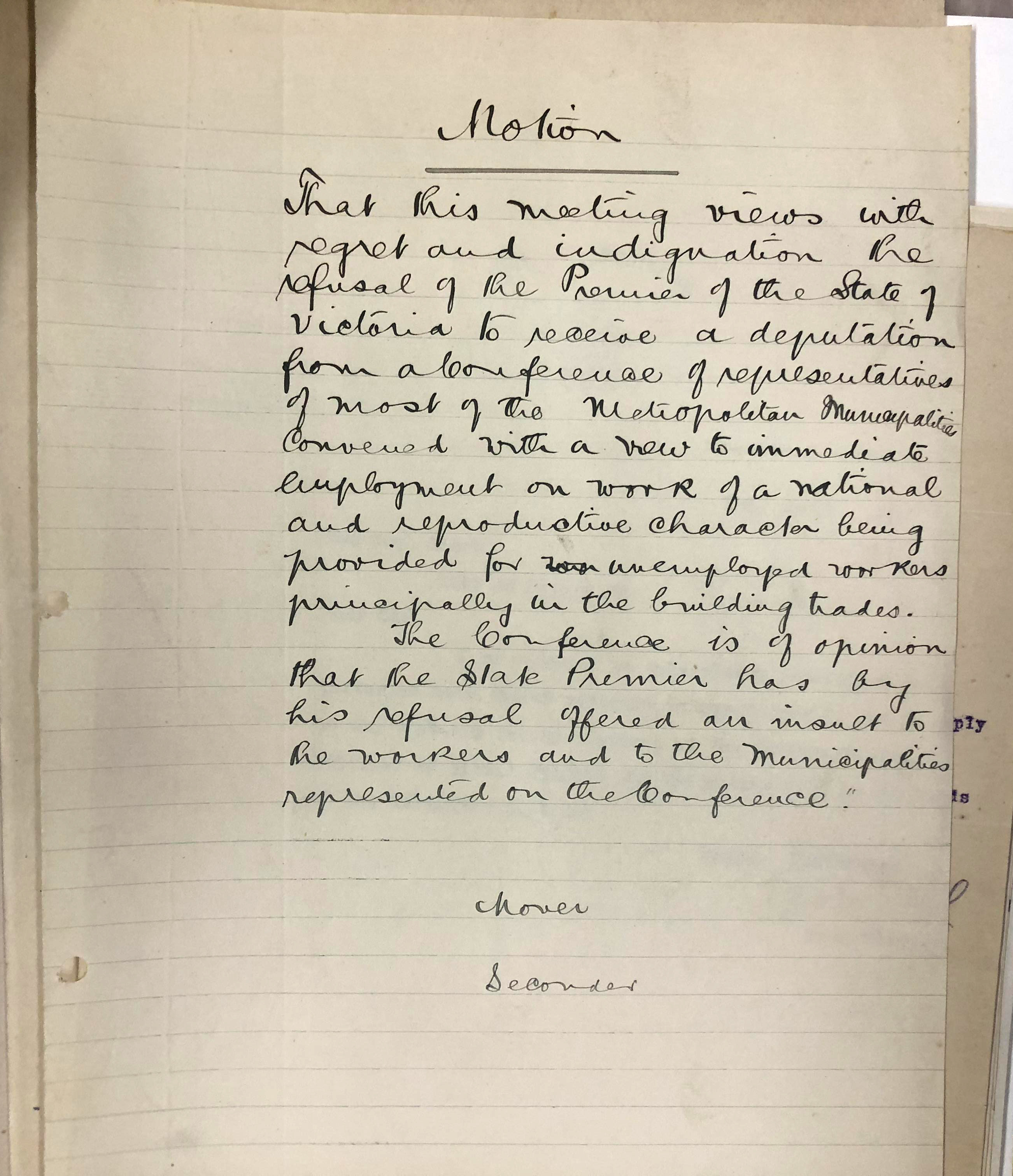Author: Carly Godden
"At a recent meeting of the Richmond City Council it was stated by local members of the Victorian Operatives Bricklayers’ Union that there was a great number of men unemployed in the building trades. The Council as representatives of ratepayers of an industrial suburb was urged to take some steps with a view to work being provided," Town Clerk, Richmond City Council, Letter to Country Municipalities Unemployment Conference Correspondence, VPRS 16668/P1 Unit 17.
"In reply to your letter of the 21st re the above matter, I beg to state that there is no building at all going on in this Shire," Town Clerk, Letter to Richmond City Council Town Clerk, Outwards Correspondence Loddon Shire Council, VPRS 18503 P1 Unit 4.
Hardship at home
Since the outbreak of World War One, the cost of living in Victoria had soared. Drought and harvest failures in 1914 meant there was not enough food to go around and prices were high. The situation was worsened by agreements entered into by the Commonwealth Government with imperial authorities to secure the export of Australian products, including beef, mutton, dairy and wheat, during the war. When problems with shipping and long distances prevented the goods from being transported, the Government made no attempt to make it available locally, leading to higher prices for limited supplies. Wastage also occurred with wheat being left to rot in railway sidings (Smart, 2016, p 42).
At the same time employment levels and real wages fell dramatically. National unemployment rocketed to over 14%. By 1917, numbers had slightly improved, although roughly one in every ten adults seeking work was unemployed. Labouring people in areas such as the working class suburb of Richmond were more vulnerable to struggle under these circumstances.
Speaking up
Melbourne was the nation’s capital from federation up until 1927 when the status was transferred to Canberra. During the war, Melbourne’s working-class activists were well placed to put pressure not only on local, but federal and state governments to address their concerns. Class division and unemployment weighed heavily in debates around enlistment. Some were concerned that those out of work would be driven to sign up out of economic necessity - so-called 'economic conscription'. As Historian Dr Judith Smart explains:
"underlying the unwillingness in working class communities to make further sacrifices, was anger about government failure to protect working conditions and standards of living," (Smart, 2015, p 54).
Richmond unemployment conference
Records held at Public Record Office Victoria can provide insights into efforts to find work for the down-and-out during the Great War. The Series VPRS 16668/P1 Unit 17 contains letters and documents relating to a Conference of Delegates of Metropolitan Municipalities on Unemployment, first convened by Richmond City Council on Thursday 29 March 1917. Representatives from Richmond, South Melbourne, Footscray, Port Melbourne, Williamstown and Fitzroy Councils attended (with Prahran and Northcote Councils noted as apologies).
The conference, which focused on the plight of men in the building trade, had received information from Trades Hall Council that 1647 men were out of work:
| Builders' labourers | 600 |
| Bricklayers | 400 |
| Carpenters | 437 |
| Painters | 100 |
| Plumbers | 80 |
| Masons | 30 |
A second meeting of the conference was held on the 29th March. Interestingly, a request was received from the Women’s Political Association to provide a deputation to the conference on unemployment amongst women. The Association had been dealing with unemployment issues since January 1915 and had provided a workroom for their relief; however the organisers determined that any deputation should be ‘postponed’ until the next meeting.
Taking action
But what was to be done? The conference endorsed the principle that:
"instead of being idle and in want in War time those should be employed by the Government on National works" [sic] and that "Unemployment is more regrettable in War time than in peace on account of the higher prices charged for the necessities of life" [sic].
Many blamed the high cost of building materials for the lack of private sector work. The organising Committee recommended that governments should create jobs in public works projects, which could include:
- constructing docks on the West Melbourne swamp
- works in Williamstown ship-building yards
- brown coal mining at Altona Bay and Morwell
- completion of the Mount Gambier Railway
- prevention of flooding of Moonee Ponds Creek and Maribyrnong River.
A request to receive a deputation from the Conference was however rejected by the Premier Sir Alexander Peacock, who replied via letter that the State Government was:
"well aware of all the facts" and "does not see that an interview would serve any good purpose". The Herald reported that with respect to the Conference, the premier commented that "In view of the very limited amount of money available, and the state of finances generally, he could not promise any additional works for the present". He further added that those out of work should accept temporary positions on farms: "I am informed that there is plenty of work in country districts" (Herald, 30 March 1917, p 1).
The grass is always greener?
Following the conference on April 21, the Town Clerk of Richmond City Council wrote to every rural Victorian municipality, explaining that:
"some Councillors held the view that there is work in the Country for all men who are unemployed in Melbourne".
The Clerk asked the municipalities:
- Is there any prospect of men in the building trades obtaining work in your district?
- If your answer be in the affirmative:
- What is the nature of the employment?
- How many men could be given employment?
- How long would the employment be likely to last.
- Information as to the wages and conditions.
The inwards correspondence file of Loddon Shire Council VPRS 18502/P1 Unit 1 held at the Bendigo Regional Archives Centre (BRAC) contains a copy of this circular letter. The Shire was not alone in communicating that there was no building work in their jurisdiction. Nearby the Shire of Donald reported that:
"There is nothing at all doing in the Building Trade in the Shire but all other classes of labor is very scarce" and that "Most of the available labour is absorbed in trucking the wheat which is being sent away as quickly as possible owing to the great damage being done by mice."
Another local municipality the Shire of Rochester also confirmed that there was a lack of demand for tradesmen in their district. However, the Shire did note that "repeated enquiries are made for farm hands", along with a number of other Shires writing that there was at least some short-term agricultural labouring work available on farms.
Ongoing unrest
Meanwhile at a third meeting of the conference on April 19, a motion was carried that the meeting viewed the Premier’s refusal ‘with regret and indignation’. The conference was of the opinion that it ‘offered an insult to the workers and to the municipalities represented on the Conference.’ On April 25 the Premier changed his mind and agreed to receive the deputation. Although VPRS 16668/P1 Unit 17 contains no further reports of that particular meeting, it is evidence of the growing disquiet over unemployment and hardship which only escalated in the coming months. Rising class tensions and resentment over conscription provided an atmosphere in which more than 20,000 workers in Melbourne and 150,000 in Sydney mobilised in the Great Strike of August and September of that year.
Records of meetings, correspondence and other documents held by Richmond City Council can be ordered online and viewed in the PROV Reading Room.
Records of correspondence held by Loddon Shire Council can be ordered online and viewed in the BRAC Reading Room.
Reference
Smart, Judith ‘A divided national capital: Melbourne in the Great War’ La Trobe Journal (2015) 96, p 28.
Material in the Public Record Office Victoria archival collection contains words and descriptions that reflect attitudes and government policies at different times which may be insensitive and upsetting
Aboriginal and Torres Strait Islander Peoples should be aware the collection and website may contain images, voices and names of deceased persons.
PROV provides advice to researchers wishing to access, publish or re-use records about Aboriginal Peoples
